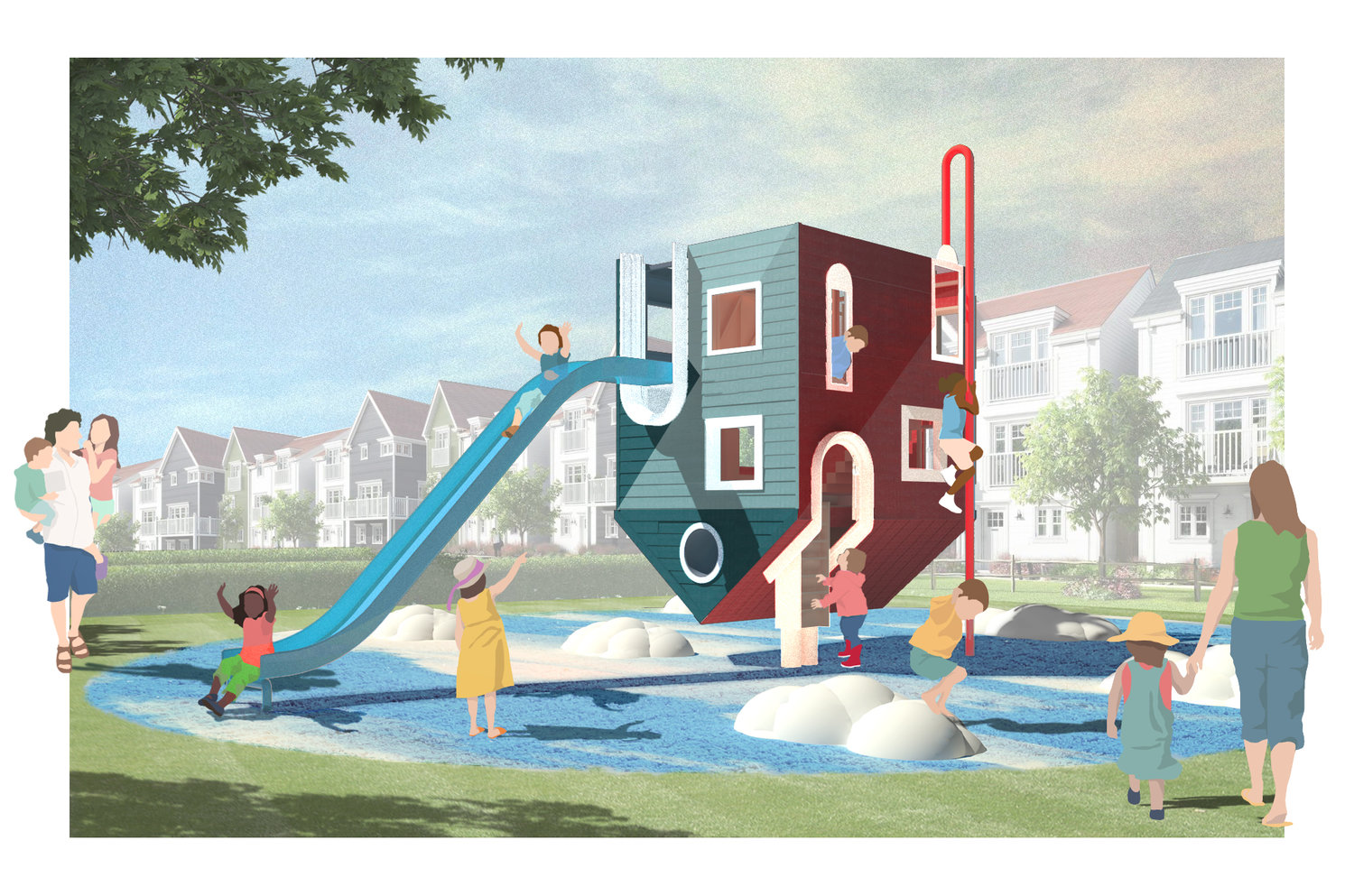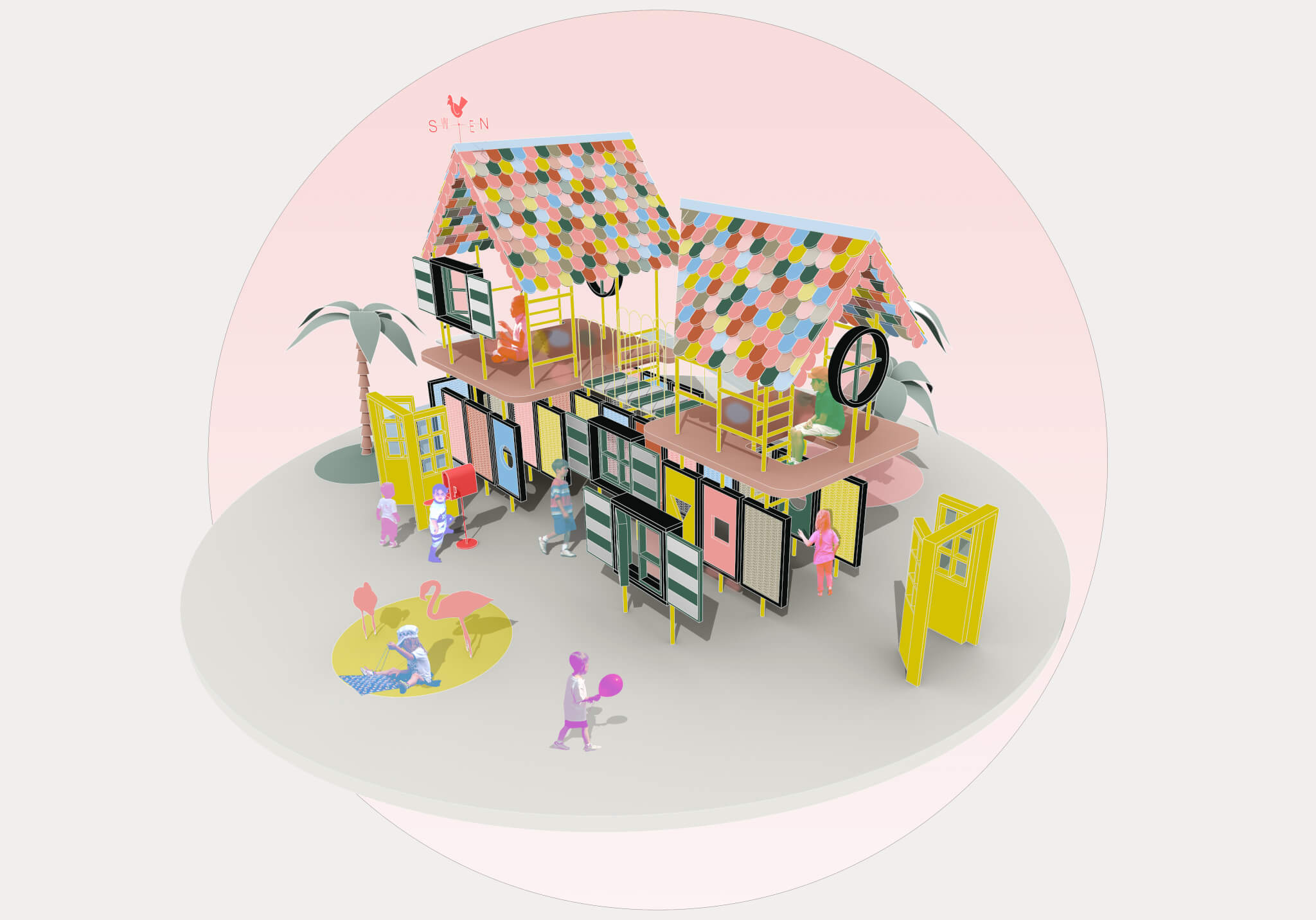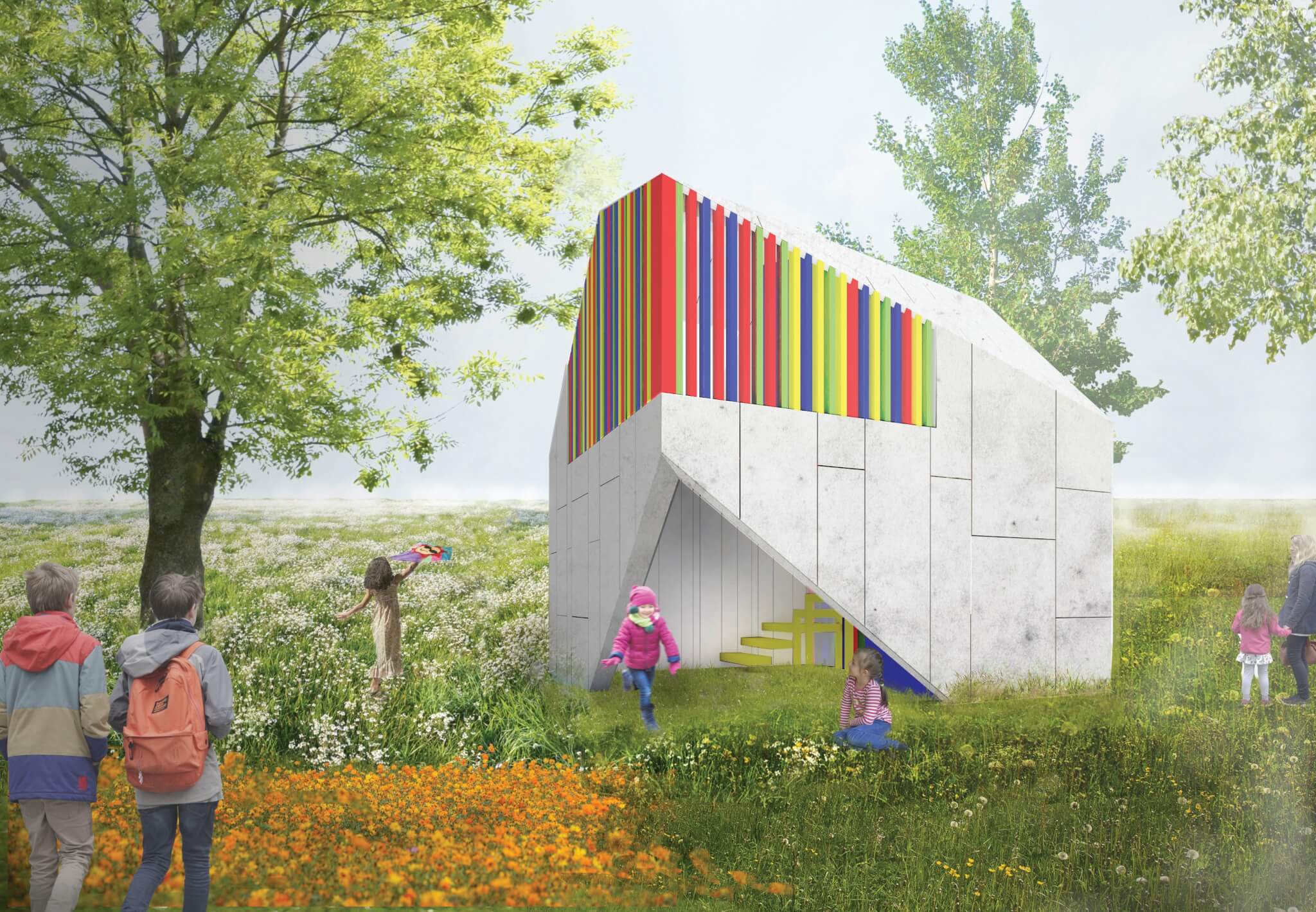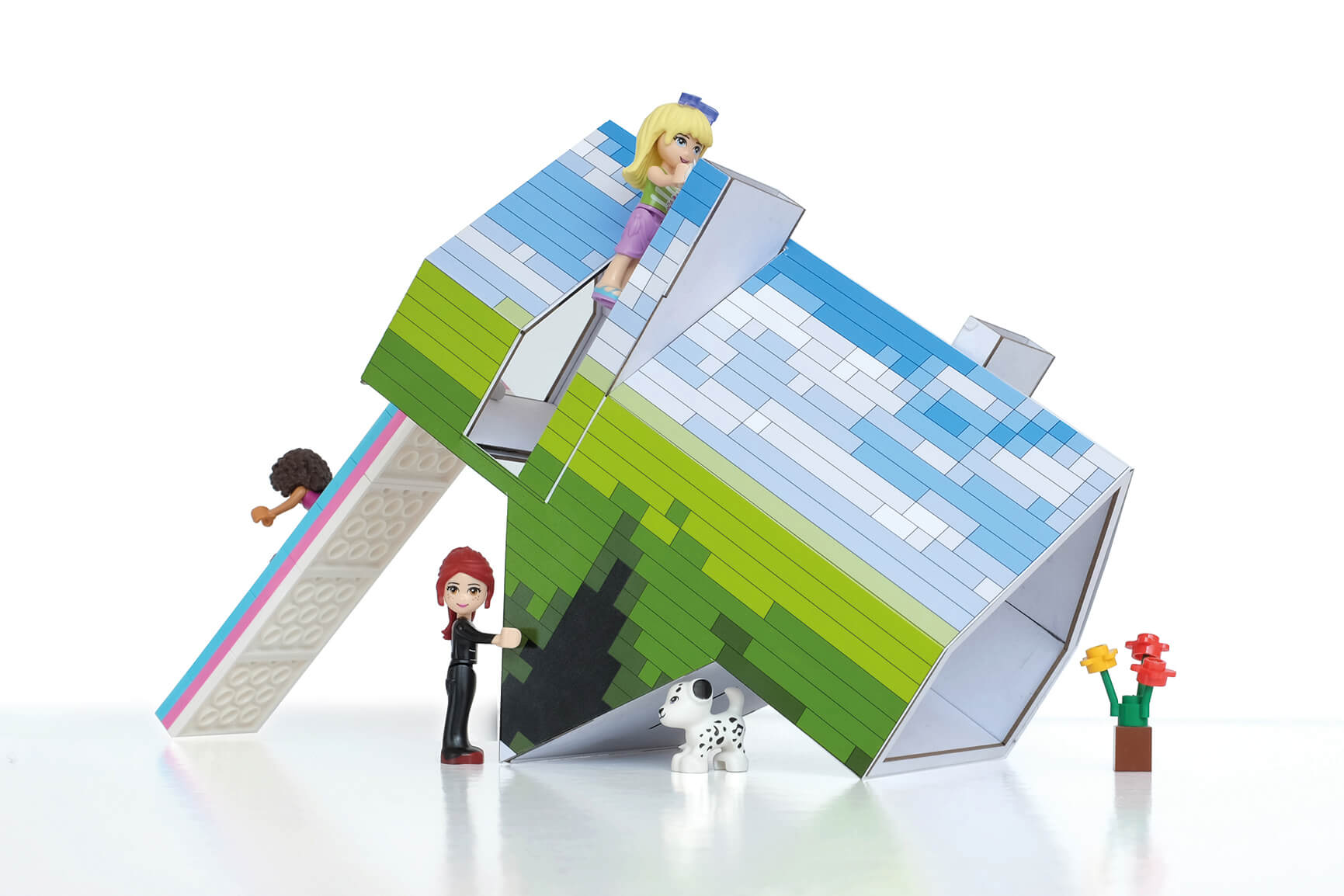The up-and-coming practice saw off strong competition from the likes of Fisher Cheng, which was highly commended, as well as ’experimental architecture office’ IJP Architects working with engineer AKT II, newcomer Adam Joyce, EPR Architects and Clerkenwell-based ALEKSA Studio.
Alma-nac, which won with its proposal the Upside Down House, is now set to build the £15,000 scheme at the Green Park Village development in Reading, which is being developed by St Edward, a division of competition associate
Berkeley Group.
While strongly appealing to children, the playhouse will also showcase emerging colour trends in residential design.
The competition judges, who included architect Will Alsop, said of the winning design: ‘The Upside Down House is a clear idea which reflects the open-ended nature of play and will really attract kids.
‘The architect has really considered colour, the technical aspects and the landscape. It’s a whole play area, not just a playhouse.’
Turning to Fisher Cheng’s highly commended proposal, The House That Eden Built, the judges called it a romantic idea ‘with an eccentric tropical aesthetic’, adding that the ‘shingle tiles, maze-like ground floor and flexibility of the concept’ had all impressed them.
The competition was sponsored by building materials firm James Hardie, a specialist in
fibre cement façade products.
The firm’s UK and Nordics marketing manager Karen Ogden, who also sat on the judging panel, called the winning design ‘unique, intriguing and full of fun’, and said it complemented Green Park Village’s New England-type housing.
She added: ‘An exhibition will soon be taking place in the Green Park Village marketing suite to engage with existing and future residents and showcase the designs. Both James Hardie and partner Berkeley are very enthusiastic about realising the winning design which we think will be a real point of interest on the development.’
The House of Colour competition received more than 40 entries from both established and up-and-coming practices, from which the shortlist of six were selected.
Each of the shortlisted practices received a £1,000 honorarium for their time and Alma-nac will receive an additional £2,500 for working up and delivering its design on a one-off basis.
Winner
The Upside Down House by Alma-nac
The Upside Down House is a playhouse that references some of the surreal worlds created in children’s stories such as Alice in Wonderland and the Pixar film Up. Its simple concept gives rise to a whole new world. The floor becomes the sky, the roof becomes the floor, enter through the chimney and slide out of the front door.
It maintains the joy of a good play/tree house – the ability to be ‘king of the castle’ and a hidden world where only children can go. Favourites like tunnels, slides, nets and ladders are all included but with a slightly strange context that sparks the imagination and forms the basis for stories and adventures alike. Each façade has its own adventures and its own colour. They can be seen as part of one house or four houses together, each with its own story. While displaying some recognisable elements associated with children’s play, the house in not intended to appear out of place in its surrounding context. Instead it draws on the formal language of Green Park Village and borrows architectural motifs from that context. The distortion and reorientation of these elements brings a sense of surreal playfulness to the suburban village landscape.
As a meeting space and destination for children and adults alike, the house is intended to be sited in an open area against a domestic backdrop, emphasising its subtle eccentricities and celebrating the colourful cladding material used throughout the village.

Highly commended
The House That Eden Built by Fisher Cheng
In the spirit of New England folk artist Earl Cunningham, The House that Eden Built explores the unsuppressed use of vivid colour, combined with the playful incongruity of unexpected objects. Cunningham’s paintings depict a unique view of New England as an Eden, and are the inspiration for the androgynous title of the project.

This year, ‘millennial pink’ has quite possibly reached its peak, with the shade proliferating catwalks and design shows alike. Although likely to hang around, its prevalence symbolises a wider trend toward hues that blur the boundary between colours that can be easily named. The use of colour combinations in more unexpected ways, as beautifully illustrated in Cunningham’s paintings, can add richness and enjoyment to the urban fabric.
The proposal draws from the colours of his painting Goose Rocks Beach, while placement of natural elements of palms, shark pools and flamingos add a cheerful and whimsical character to enhance children’s delight. Intrinsic to the idea is the requirement of children’s imagination in their interaction with the playhouse. There are no formal boundaries to the playhouse. Interactive panels that swivel with a push allow children to define their own spaces. A lonesome door may demarcate an invisible threshold into any space of the imagination. Windows are positioned where walls might be. The roofscape is further deconstructed to encourage imagination at spatial transition zones.
Finalist
The Cave by Adam Joyce
The design proposes the playhouse as a free-standing pavilion. It also echoes the simplest form of shelter or home; a cave-like structure that appears as if a child has drawn the house with slanting walls and simple openings.
The spaces within the playhouse are seen as a number of rooms, each with its own spatial quality and use, containing spatial and level changes with which the children can explore and interact. The building is clad in simple white fibre cement panels with a stucco texture, but have an order that stretches around from the wall and over the roof. The form is simple and monolithic, with punched-in openings in the walls and roof. External colour is expressed via battens on the façade. These are hinged so they turn in the wind or, where they are accessible, by the children.
Openings are varied. A large skylight is positioned near the centre of the plan to allow light and air into the middle, giving prominence to this space. Various smaller openings are provided around the building, relating to the use of the space behind the façade, but also providing views of the colour and the interior from outside. The edge of the playhouse has been lifted to form a cave-like opening, which also allows glimpses into the centre of the building and the strong coloured elements of the interior.

Finalist
Unfolded House of Colour by Aleksa Studio
Inspired by Bruno Taut’s interest in coloured architecture and Gio Ponti’s use of colour and pattern, our proposal attempts to emphasise geometry and colour in a playful composition.
The house of colour appears to unfold from the ground and combines a lively landscape and a timber folly clad in a mix of colourful planks – some perforated to allow glimpses, light and sound to pass through. Children can climb up the sloped surfaces, slide down, peek through the structure, or play hide and seek, with the pattern and colour leading their way in and around the house.
The arrangement of the tiles and the colour combination will also create a sense of perspectival illusion with some surfaces appearing to be three dimensional, encouraging children to discover the architecture through play.
The house can be digitally fabricated with James Hardie products cut to size and assembled together with the timber frame structure in components off site. This method of construction will ensure fast assembly on site and ease of repetition on various locations as required. We would also like to ensure that the house can be disassembled, stored safely and reused. The design uses a combination of smooth and cedar finish Hardie Plank or Hardie Panel fibre-cement products. We are proposing two colours installed in alternating patterns. The planks will be used as vertical cladding and landscape flooring.
Finalist
The Jellyfish Tree House by EPR Architects with Karen Haller, Materials Council and the Royal Society for Blind Children
In collaboration with the Materials Council and colour psychologist Karen Haller, we have designed two playhouses in support of the Royal London Society for Blind Children (RSBC) to raise awareness of the challenges facing young blind and visually impaired people, while offering a fun and inclusive play area for children of all abilities to play together.
We asked families supported by RSBC to describe their ideal playhouse and what they would like to find inside. Based on the responses we received from the visually impaired children, we propose two pavilions, each housing a different activity and experience. One encloses a trampoline which will help the children to develop their balance and agility, and the other a sensory room for quieter children.
Our aim is to create a different take on the classic treehouse den by creating a permeable jellyfish pavilion of hanging, swaying soft textile tubes. It’s a playhouse with no walls, barriers or restrictions, enabling children to play freely and be imaginative while taking in the goodness of natural light and fresh air in a fun, safe space where everyone is welcome and equal.
Various tube diameters with different fabric thicknesses create a sensory experience for children moving through the space. This sensory curtain is suspended from a heavyweight climbing net. With adult supervision, children can play on the supporting net which also features a cantilevered slide.
Finalist
Play House of Colour by George L Legendre of IJP Architects and Edoardo Tibuzzi of AKT II
Young children like exploring spaces and building dens. Older ones love climbing up walls and racing down slides. Playhouse of Colour offers children of all ages a range of safe and exciting experiences.

There are many ways of engaging with the hollow, gable-profiled house. You could walk in and up across its slanting floor to catch the cool slide. Walking against the grade (with the help of handles) is a lot of fun! Alternatively, you could get in via the external climbing wall, then catch the slide or walk down the slope and back out again. Bold climbers (like the blond girl on the board), will easily reach the chimney end of the climbing wall. Toddlers (like the little dog) will crawl in the den underneath. Its interior is always open to visual inspection by adults.
Our concept is realised through colour, and specifically, through digital colour: the dimensions and appearance of the siding boards are determined by the fidelity and colour depth of a sampled image. While the width of the boards is fixed (factory made at 180mm), their length will depend on the nature of the sampled image – detailed areas require shorter board sizes, whereas coarse areas can be rendered with longer board sizes. The amount of detail is directly proportional to the sampling of the original image and the desired number of colours. This proposal features 18 and is based on the picture of a green field.